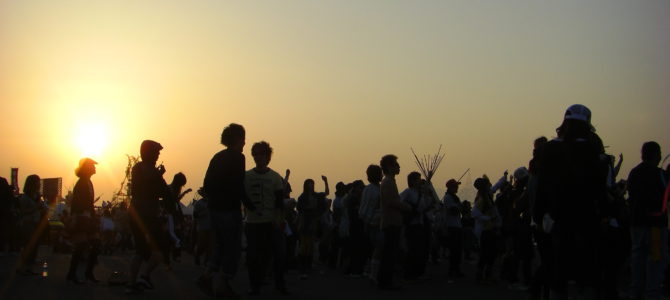
From HBO’s account, “Woodstock 99: Peace, Love, and Rage” looks like it was a bacchanalian nightmare of angry people dehydrating under the hot sun.
The music festival was planned to be a 30-year anniversary celebration of the original Woodstock — with peace, free love, and drugs — but in practice, according to accounts from the documentary, those hippie vibes were nowhere to be found. Instead, angry music was the background to sexual assaults, looting, and riots.
But the documentary’s commentators make the failed sequel seem even worse than it was, finding sexism and racism among the naked women and young white men.
That weekend in the summer of 1999, a youth culture full of uncertainty and anger, mixed with a frenzy of consumerism, took its toll on a patch of ground in New York state. It was only a few months after Columbine, the first major high school shooting, and the era of grunge was over.
The bands selected for the three-day fest were primarily angry new metal, with Jewel, Sheryl Crow, and Alanis Morissette randomly thrown in. Bands like Metallica, Korn, Creed, and Limp Bizkit were the primary draw.
The footage is nauseating: kids piled together in a toxic sludge after water ran out and porta-potties overflowed. But what really stood out in this documentary were two things: accounts of sexual assault and rape, and the documentary’s commentators’ outright disdain for the festival attendees more than 20 years later.
Sexual Exploitation and Racism
The documentary makes several broad assumptions. The first is that women who show off their sexuality are being unknowingly exploited, and that their willingness to show their bodies was proof of their victimization. The second is that the white people of the 1990s were terrible, racist people and they just didn’t know it yet, but they should have.
Security guards who were working that weekend spoke about the men in the crowd behaving like “savages,” tearing girls’ clothes off. The promoter said there were 10 incidents of rape reported, but this is likely an undercount given how many sexual assaults routinely go unreported. The promoter also pointed out what the documentary makes clear: women were walking around the festival essentially naked.
“I am critical of the hundreds of women that were walking around with no clothes on and expecting not to be touched,” the promoter says in the documentary. “They shouldn’t have been touched, and I condemn it, but, y’know, I think that women that were running around naked, y’know, are at least partially to blame for that.”
This is a perspective that Spin Magazine’s Maureen Callahan takes issue with, as do other feminists. To some, a woman should be able to parade through a hard rock festival full of angry young men while fully naked and it should be as safe as if she were in her own home.
While it may be a nice fantasy to imagine that all men should be in total control of their aggression and sexual impulses at all times, it isn’t reality. Women should probably be aware of that. They won’t always be able to avoid an overly aggressive male, but women also don’t have to walk around naked in a crowd of 50,000 men.
The film takes pity on not only the women at “Woodstock 99,” but women of that era in general. As a woman of that era, I have to say outright: we didn’t think we were much different than men. We wanted sex, we wanted drugs, we wanted rock and roll, and we figured it was our right to have them.
For the commenters all these years later, whiteness was also the problem at the 1999 festival. The documentary takes specific aim at young white men. That demographic that everyone loves to hate was actually not so hateful back in the 1990s.
What the documentary forgets is that the kids of the ’90s were essentially colorblind. They didn’t think there was a difference between white and black kids, and it would be more than a decade before they realized that believing in equality was racist.
Why So Angry?
One of the documentary’s points is that the festival went so incredibly badly because of the rock musicians. Some say Limp Bizkit practically incited the riots on the last night of the festival. Attendees burned down one of the stages after not-for-profit volunteers handed out candles for a Columbine vigil.
Spin’s Callahan says, “I mean, kids are ripping open ATM machines with their bare hands, and lighting Mercedes Benzes on fire, I mean they’re telling you what they think of your greed.” For Callahan, corporatism was part of the problem. The kids didn’t like being commodified, their tastes and allegiances bought and sold.
“It’s a very weird thing that you see at the end of the ’90s,” MTV VJ Dave Holmes said. “There’s just this simmering anger, and it manifests itself through sludge and angst.”
DJ Moby spoke against the white anger of Woodstock. “A lot of times when white people have embraced hip hop they’ve ignored the funk, they’ve ignored the R&B, they’ve ignored the subtlety and they’ve embraced homophobia and misogyny,” he said of new metal artists like Kid Rock and Korn.
“The same thing with metal. There’s a lot of wonderful, celebratory, joyful, fun metal, but somehow new metal embraced the troglodyte elements,” Moby continued. He blamed “money” for the co-opting of youth culture.
The original Woodstock, however, was organized by music industry insiders. Maybe they had lots of feels for the kids, but they were in it to make money, too. That American ethos has never changed.
What Were They Fighting?
But nothing big was going on in 1999, instead, everything big was on the horizon — and we all knew it. Jewel, one of only three female-fronted acts, said, “The Gen Xers and the next generation really weren’t fighting anything. I think the only thing we were fighting is we wanted to be angsty, and we wanted to be deep. I think the only thing we were really fighting is we didn’t feel like we had a purpose.”
In her view, part of the problem with the three-day concert was that there wasn’t really a “soulful purpose for the show.”
The anger in the music from Rage Against the Machine and the other heavy acts that made out the line-up was in part about fear and uncertainty, wanting to be prepared to take on whatever was coming, whether it was Y2K, school shootings, or some other incredible unknown.
It was only two years before 9/11, and the kids had no idea what the new century would hold. No wonder they were on edge.









